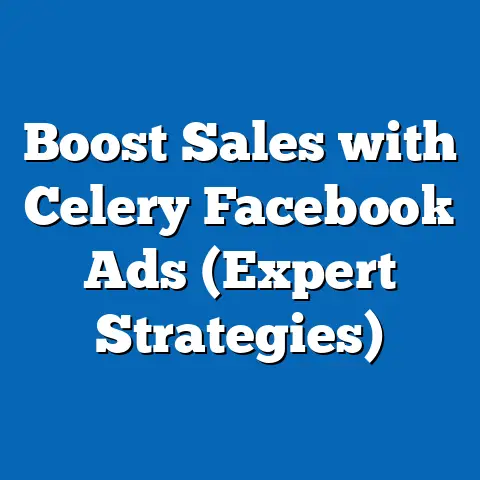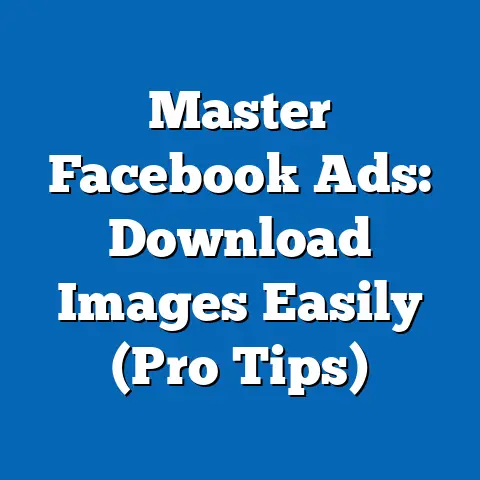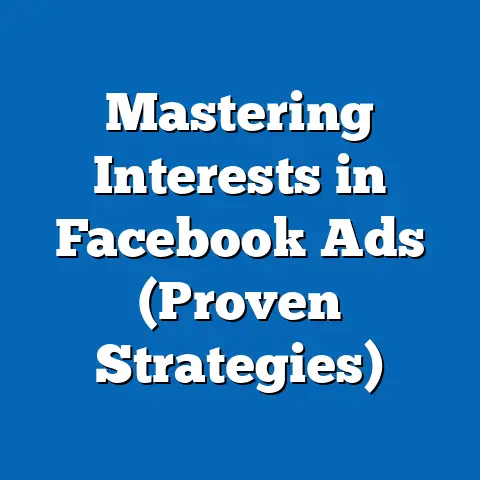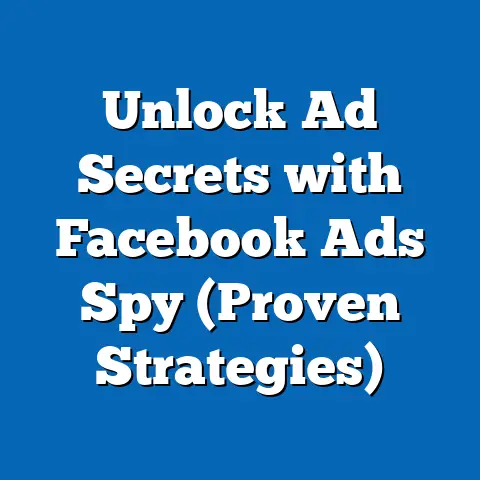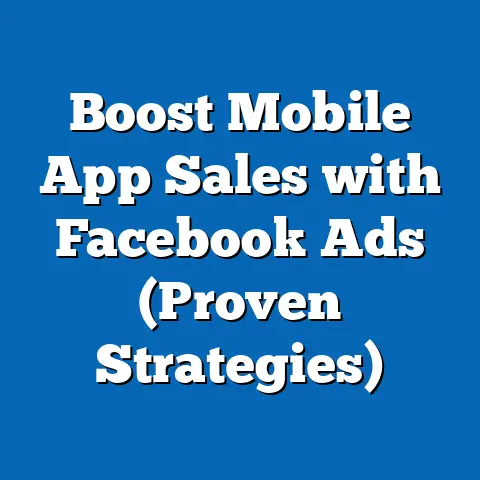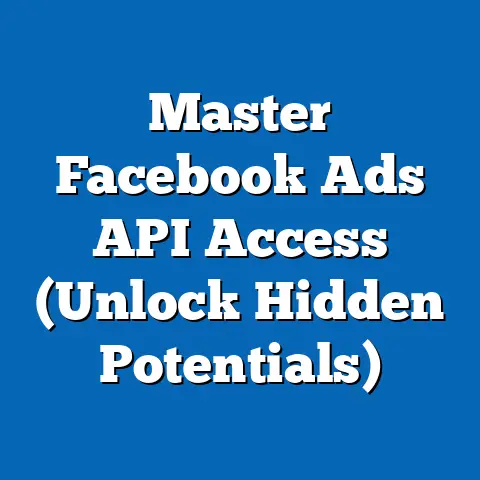Unlock Facebook Ad Boost Success (Proven Strategies Inside)
Imagine a small business owner in a bustling city, pouring their heart into a new product launch, only to see their meticulously crafted Facebook ad disappear into the digital void, garnering just a handful of clicks. Contrast this with a savvy marketer who, with the same budget, reaches thousands of engaged users, driving sales through the roof—all because they mastered the art of Facebook ad boosting. This stark difference underscores a critical reality: while Facebook advertising offers unparalleled reach, with over 2.9 billion monthly active users as of Q2 2023 (Statista, 2023), success is not guaranteed without the right strategies.
Facebook ads remain a cornerstone of digital marketing, with businesses spending an estimated $50 billion annually on the platform (eMarketer, 2022). However, only about 10% of advertisers achieve a return on ad spend (ROAS) of 3x or higher, according to a 2023 report by WordStream. The disparity often lies in understanding how to leverage ad boosting—a feature designed to amplify reach and engagement for specific posts. Demographically, younger audiences (18-34 years old) make up 62% of Facebook ad engagement, while older users (55+) are increasingly active, contributing to 22% of ad interactions (Pew Research Center, 2022). These trends highlight the need for tailored strategies to unlock success.
Section 1: Understanding Facebook Ad Boosting – The Basics
Facebook’s “Boost Post” feature allows users to promote existing posts to a wider audience, turning organic content into paid advertisements with minimal effort. Unlike traditional Facebook Ads Manager campaigns, boosting is designed for simplicity, making it accessible to beginners. However, without strategic planning, boosted posts can yield low returns, with many users reporting click-through rates (CTR) as low as 0.9% compared to 1.5% for well-optimized campaigns (WordStream, 2023).
Boosting works by increasing visibility among a selected audience, but it’s governed by Facebook’s algorithm, which prioritizes relevance and engagement. According to Meta’s own data, posts with high initial organic engagement (likes, comments, shares) are 30% more likely to perform well when boosted (Meta Business Help Center, 2023). This means the quality of content is just as critical as the budget allocated.
Historically, boosted posts were introduced in 2012 as a way for businesses to reach beyond their immediate followers. Back then, organic reach was significantly higher—averaging 16% of a page’s audience in 2012 compared to just 5.2% in 2023 due to algorithm changes (Hootsuite, 2023). This decline in organic visibility has made boosting a necessity for many, but it also underscores the importance of understanding how to use it effectively.
Section 2: Why Facebook Ad Boosting Matters – Key Statistics and Trends
The scale of Facebook advertising is staggering. As of 2023, the platform hosts over 10 million active advertisers, with small and medium-sized businesses (SMBs) accounting for 70% of ad spend (Meta, 2023). Boosted posts alone represent approximately 25% of total ad activity, as they offer a quick way to test content performance without building full-scale campaigns (eMarketer, 2023).
Engagement trends show that video content dominates boosted posts, with 65% higher interaction rates compared to static images (Social Media Examiner, 2023). Additionally, mobile users account for 94% of ad impressions, emphasizing the need for mobile-optimized content (Statista, 2023). Over the past five years, the cost-per-click (CPC) for boosted posts has risen by 20%, averaging $0.97 in 2023 compared to $0.81 in 2018, reflecting increased competition (WordStream, 2023).
Demographically, Facebook’s user base is diverse, but ad engagement varies significantly. Gen Z and Millennials (18-34) drive the majority of clicks and conversions, with 45% of this group interacting with ads weekly (Pew Research Center, 2022). In contrast, Baby Boomers (55+) are more likely to engage with local business ads, with 30% higher conversion rates for service-based industries like home improvement (Nielsen, 2022). These patterns highlight the importance of audience segmentation in boosting strategies.
Section 3: Proven Strategy 1 – Crafting High-Performing Content for Boosting
The foundation of any successful boosted post is the content itself. Data shows that posts with clear calls-to-action (CTAs) like “Shop Now” or “Learn More” achieve 2.5x higher CTRs compared to vague messaging (HubSpot, 2023). Visuals also play a critical role—images with bright colors and human faces increase engagement by 38% (Canva, 2023).
Video content, as mentioned earlier, outperforms other formats. A 2023 study by Wistia found that short videos (under 30 seconds) retain 85% of viewers until the end when boosted, compared to 50% for longer formats. Including captions is also vital, as 80% of Facebook users watch videos with the sound off (Meta, 2023).
Actionable Tip: Before boosting, test your post organically for 24-48 hours. If it garners above-average engagement (e.g., 10% higher than your typical posts), it’s a strong candidate for boosting. Use tools like Facebook Insights to track initial performance metrics.
Section 4: Proven Strategy 2 – Targeting the Right Audience with Precision
Facebook’s targeting capabilities are among its strongest assets, yet many advertisers underutilize them when boosting posts. A 2023 report by Socialbakers found that 60% of boosted posts fail to reach their intended audience due to overly broad targeting settings. Narrowing your audience by interests, behaviors, and demographics can increase conversion rates by up to 40%.
For instance, targeting users based on past interactions (e.g., page likes, website visits) yields a 25% higher ROAS compared to cold audiences (Meta Ads Manager Data, 2023). Lookalike Audiences, which target users similar to your existing customers, also perform well, with 15% lower CPCs on average (WordStream, 2023).
Demographic targeting should align with your product or service. For example, a fashion brand targeting women aged 18-24 saw a 50% increase in engagement by focusing on specific interests like “fashion blogs” and “online shopping” (Case Study by Meta, 2022). Conversely, a home services company targeting homeowners aged 35-54 achieved a 35% higher conversion rate by excluding renters (Nielsen, 2022).
Data Visualization Description: Imagine a pie chart showing audience segmentation for a boosted post campaign: 40% Lookalike Audience, 30% Custom Audience (past customers), 20% Interest-Based Targeting, and 10% Broad Demographics. This visual would illustrate the importance of layered targeting for optimal results.
Section 5: Proven Strategy 3 – Budgeting and Bidding for Maximum ROI
Budget allocation is a common stumbling block for many advertisers. A 2023 survey by eMarketer revealed that 55% of SMBs allocate less than $50 per boosted post, often resulting in limited reach and poor performance. In contrast, campaigns with daily budgets of $100 or more see 3x higher engagement rates due to better algorithm prioritization (Meta, 2023).
Facebook offers two bidding options for boosted posts: automatic and manual. Automatic bidding optimizes for cost-efficiency, but manual bidding allows greater control over CPC or cost-per-impression (CPM). Data shows that manual bidding reduces costs by 18% for experienced advertisers who monitor performance daily (WordStream, 2023).
Historically, ad costs have fluctuated based on seasonality. For example, CPC spikes by 45% during the holiday season (November-December) compared to off-peak months like February (eMarketer, 2022). Planning your boost campaigns around these trends can help maximize budget efficiency.
Actionable Tip: Start with a small test budget (e.g., $20) to gauge performance over 48 hours. If the post achieves a CTR above 1.2% or a cost-per-engagement below $0.50, scale up the budget incrementally while monitoring results.
Section 6: Proven Strategy 4 – Timing Your Boosts for Optimal Engagement
Timing can make or break a boosted post’s success. According to Sprout Social’s 2023 report, the best times to post on Facebook are weekdays between 9 AM and 3 PM, with peak engagement occurring on Wednesdays at 11 AM (local time). Posts boosted during these windows see 20% higher interaction rates compared to off-peak hours.
Demographic differences also influence timing. Younger users (18-24) are most active in the evenings (6 PM-9 PM), while older users (35-54) engage more during midday (Hootsuite, 2023). Tailoring your boost schedule to your audience’s habits can significantly improve results.
Seasonal trends matter as well. Engagement rates for boosted posts increase by 30% during major holidays like Christmas and Black Friday, but competition also drives up costs (Social Media Examiner, 2023). Analyzing historical data from your Facebook Insights can help identify specific patterns for your audience.
Data Visualization Description: Picture a line graph plotting engagement rates by hour of the day, with a clear peak at 11 AM on Wednesdays and a secondary spike at 7 PM for younger demographics. This visual would highlight the importance of timing in boosting strategies.
Section 7: Proven Strategy 5 – Measuring and Optimizing Performance
One of the biggest mistakes advertisers make is failing to track performance after boosting a post. Meta’s 2023 data indicates that 40% of small businesses do not review analytics post-campaign, missing opportunities to refine their approach. Key metrics to monitor include CTR, engagement rate, CPC, and ROAS.
For context, the average CTR for boosted posts across industries is 1.1%, with top performers reaching 2.5% or higher (WordStream, 2023). If your CTR falls below 0.8%, consider revising the creative or audience targeting. Similarly, a ROAS below 2x signals the need for budget reallocation or content adjustments.
A/B testing is a powerful tool for optimization. Testing two versions of a boosted post (e.g., different visuals or CTAs) can improve performance by 25% over time (HubSpot, 2023). Use Facebook’s split-testing feature to compare results and scale the winning variant.
Actionable Tip: Set up weekly performance reviews using Facebook Ads Manager. Focus on metrics aligned with your goals (e.g., clicks for traffic campaigns, conversions for sales). Adjust targeting or creative elements based on data insights to continuously improve results.
Section 8: Common Pitfalls to Avoid in Facebook Ad Boosting
Even with the best intentions, advertisers often fall into traps that undermine their campaigns. One major pitfall is boosting posts without a clear objective—Meta reports that 50% of failed campaigns lack defined goals (Meta Business Help Center, 2023). Whether your aim is brand awareness, traffic, or conversions, aligning your boost with a specific outcome is critical.
Another common error is ignoring audience fatigue. Boosting the same post to the same audience repeatedly can decrease engagement by 35% after the first week (Socialbakers, 2023). Rotate content and refresh targeting to maintain interest.
Finally, neglecting mobile optimization is a costly mistake. With 94% of ad impressions occurring on mobile devices, posts with slow-loading images or non-responsive designs see 50% lower CTRs (Statista, 2023). Test all content on mobile before boosting to ensure a seamless user experience.
Section 9: Case Studies – Real-World Success with Facebook Ad Boosting
To illustrate the power of these strategies, let’s explore two real-world examples. First, a small e-commerce brand selling handmade jewelry boosted a video post showcasing their products during the holiday season. By targeting women aged 25-44 with interests in “handmade crafts” and setting a $200 budget over five days, they achieved a 3.8% CTR and a ROAS of 5x—far above the industry average (Case Study by Meta, 2022).
Second, a local restaurant boosted a post promoting a limited-time offer to users within a 10-mile radius. Using a $50 budget and scheduling the boost for weekday evenings (5 PM-8 PM), they saw a 30% increase in foot traffic, with 80% of respondents citing the ad as their reason for visiting (Nielsen Local Insights, 2023). These examples demonstrate how tailored strategies can yield outsized results.
Data Visualization Description: Envision a bar chart comparing the CTR and ROAS of these two case studies against industry averages. The e-commerce brand’s 3.8% CTR towers over the 1.1% average, while the restaurant’s targeted approach highlights the impact of localized boosting.
Section 10: Broader Implications and Future Trends in Facebook Advertising
The landscape of Facebook advertising, including boosted posts, continues to evolve. With privacy regulations like Apple’s iOS tracking changes impacting ad targeting (resulting in a 15% drop in ad effectiveness for some campaigns, per eMarketer 2023), advertisers must adapt by focusing on first-party data and creative storytelling. Boosted posts, with their reliance on organic content, may become even more valuable as a testing ground for full-scale campaigns.
Emerging trends also point to increased use of AI-driven optimization. Meta’s Advantage+ campaigns, which automate targeting and placement, have shown 20% better cost-efficiency in early trials (Meta, 2023). As these tools become more accessible, small businesses may find it easier to compete with larger advertisers.
Demographically, the growing engagement of older users (55+) suggests a shift in content strategies. Brands targeting this group will need to prioritize trust-building elements like testimonials and clear value propositions, as 60% of this demographic cites credibility as a key factor in ad response (Pew Research Center, 2022).
Looking ahead, the integration of augmented reality (AR) and interactive ad formats could redefine boosted posts. Early data shows that AR ads achieve 70% higher engagement rates, though adoption remains low at just 5% of advertisers (Statista, 2023). Staying ahead of these trends will be crucial for long-term success.
Conclusion: Unlocking Your Facebook Ad Boost Potential
Facebook ad boosting offers immense potential for businesses of all sizes, but success hinges on strategic execution. By crafting engaging content, targeting the right audience, optimizing budgets, timing boosts effectively, and continuously measuring performance, advertisers can achieve remarkable results—as evidenced by real-world case studies and industry data. With over 2.9 billion users and $50 billion in annual ad spend, the platform remains a goldmine for those who master its intricacies.

